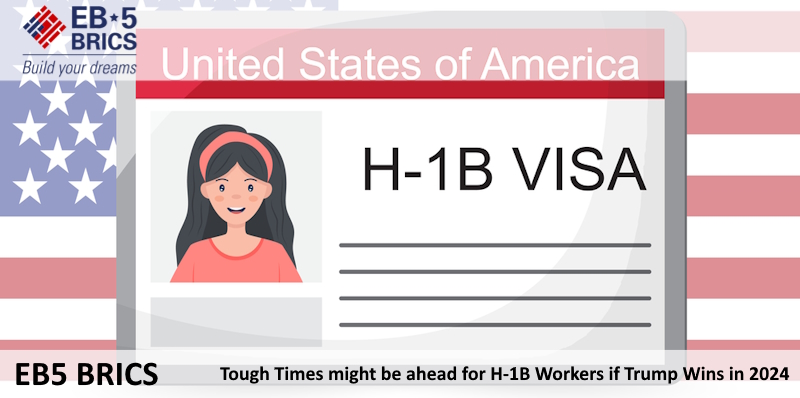What would a Trump win in 2024 possibly mean for H-1B workers in the US?
A comprehensive victory in the Iowa caucus followed by the exit of two candidates from the race has made Trump the likely Republican nominee for the 2024 US Presidential elections. Some polls even have him leading against President Biden, which means Trump may even have a good chance of becoming the next President.
These may be early days yet but it is worth analyzing what a Trump win in 2024 would possibly mean for H-1B workers in the US.
In the past, the program was the target of harsh rhetoric, controversial proposals, and multiple changes to the rules through regulations and Executive orders. These changes made it tougher for employers to hire H-1B talent and pushed skilled talent out of the US.
Re-election in 2024 may serve as validation of Trump’s past policies and may bring about harsher changes and even more challenges for H-1B workers ahead.
Trump’s First Term—Impact on the H-1B Visa
Trump’s first term was punctuated by rhetoric and hyperbole combined with Executive orders ostensibly aimed at ‘reforming’ the H-1B program.
The 2017 Executive Order Buy American and Hire American resulted in increased scrutiny on the H-1B visa program.
The Trump years were marked by multiple changes that made it extremely challenging for workers to qualify for H-1B visa issue or renewals. These included
- A USCIS memo instructing adjudicators to avoid deferring to findings of previously approved applications. This led to renewals being subjected to the same level of scrutiny as new applications
- A USCIS memo requiring stricter interpretation of specialty occupations. This impacted tech workers whose positions suddenly became ineligible for the H-1B visa
- A USCIS memo that allowed issue of H-1B approvals with validity periods shorter than the period requested in the petition. There was an instance where H-1B approval was granted in February 2019 with visa validity of just one day.
- Higher scrutiny of H-1B visa holders working in third-party worksites including compliances and documentation requirements aimed at making it very difficult for employers to continue employing H-1B workers.
- Incorrect implementation of anti-benching provisions of an existing law to deny H-1B approvals unless proved that the worker would be working continuously throughout the validity period of the visa.
- Multiple suspensions of premium processing—enabling H-1B adjudication within 15 days—between 2017 and 2020. This meant US companies hiring H-1B workers had to wait up to one year for adjudication.
- Higher wage requirements introduced in 2020 that resulted in H-1B workers being virtually priced out of the job market. This was eventually shelved by the Biden administration.
- USCIS memo rescinding a prior guidance recognizing computer programmer as a specialty occupation.
- Suspension of entry of H-1B workers into the US from June 2020 to March 31, 2021. This suspension was allowed to expire by the Biden administration.
Indian IT companies and tech workers bore the brunt of these changes as H1-B denials quadrupling from 6% in 2015 to 24% in 2018.
Some policy memos were struck down by the courts while other changes did not extend beyond the end of the Trump administration. Denial rates fell from stratospheric levels to 2% in 2022, although this was of little consolation to those who could not get or renew their H–1B visas in this period.
Trump Reelection—Future of the H-1B Visa
Tech workers may be hit hard as there may be renewed focus on the definition and interpretation of specialty occupations. Denials may surge once again for initial as well as continuing H-1B petitions.
Deployment of H-1B workers in third-party worksites may once again come under the spotlight and the burden of fulfilling all compliances related to the visa may once again shift to the client company instead of the company hiring the H-1B worker. Such workers may be issued one-year visas, which may lead to additional renewal formalities as well as continuing uncertainty about quick approvals.
Higher wage requirements for H-1B workers may be reintroduced and the lottery system may be replaced by wage ranking system where highest-paid H1-B workers may be issued visas first.
Optional Practical Training (OTP) too may see changes and it may become tougher for students to rely on the F1to OPT to H-1B route for eventual permanent residence through an EB-category visa.
The negative impact of these changes may be exacerbated if, as in Trump’s first term, these are introduced through piecemeal changes through USCIS memos and Executive orders. The uncertainty may make it very tough for employers, H-1B workers, as well as international students in the US to plan their future.
With little clarity on how the Trump-led crackdown will reshape preferred non-immigrant work permit for foreign workers, H-1B visa holders may well consider exploring alternatives like the EB-5 visa.
Investing $800,000 in a Targeted Employment Area (TEA) or $1.05 in a non-TEA project and creating ten full-time jobs in the US can help you qualify for two-year conditional permanent residence in around 18-24 months.
The EB-5 Reform and Integrity Act of 2022 allowing concurrent filing of Adjustment of Status petitions, which means a H-1B worker in the US can file the I-526 and I-485 simultaneously.
Further, the investor can apply for Employment Authorization Document the investor may apply for EB-5 Employment Authorization Document to legally work in the US and Advance Parole to travel outside the US pending adjudication on the I-485.
Further, working with a SEC and FINRA-registered broker dealer can help EB-5 applicants identity the right Regional Center project suited to their risk tolerance to maximize the chances of return of investment.
With little clarity on how the H-1B program will look from January 2025, the smartest and safest option for H-1B visa holders to safeguard their future in the US would be consider the EB-5 route to the green card.
Contact us for a One-on-One Meeting with Vivek Tandon, Esq a US Lawyer and Investment Banker.





